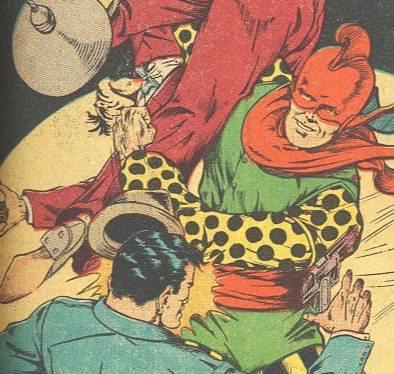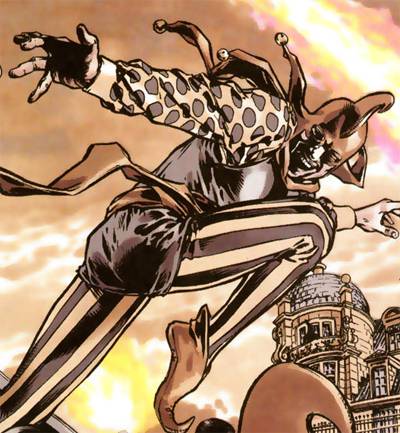This is the page for the original Jester, Charles Lane.
For the current Jester (of the same name) see the Jester page.
Origin

Chuck Lane was a product of his ancestors. He was the direct descendant of Walter Delane, a court jester to King Arthur. His ancestors came over from England to America, where they became members of a secret society called the Arcadians, subtly influencing America both through politics and behind-the-scenes. Chuck, however, did not want to enter politics, deciding to become a policeman instead. Though his parents were disappointed, they allowed him to choose his career. So, Chuck graduated from the police academy to become a beat cop, working under Inspector Mulligan, and later the inept Inspector McGinty.
His Arcadian parents, wishing to continue to manipulate America’s future, convince Chuck that being a cop is not enough. The United States must enter World War II to allow them to use the atomic bomb, which the Arcadians believe will lead to an era of American dominance. Chuck agreed, and used his ancestor as inspiration and became the masked vigilante known as the Jester. Using gimmicks and clown-like accessories, the Jester made the criminals he fought the punch-line.
Creation

The Jester was created for Quality Comics by golden age artist Paul Gustavson. Gustavson was also known as the creator for other super-heroes for Quality, including the Human Bomb. The Jester’s writer, unfortunately, has been lost to the annals of time. The Jester debuted in Smash Comics #22, published in May of 1941, alongside Black X, Bozo the Robot, Midnight, the Ray, and Wings Wendall. The Jester proved extremely popular, appearing in the next 64 issues of Smash Comics, until the series was cancelled in 1949. Gustavson continued as the artist until issue #39, where he was replaced by an unnamed artist.
Character Evolution
The DC Years

In 1956, Quality Comics, the original publishers of the Jester, closed shop. In 1957, DC Comics purchased the right to publish the Quality stable of characters, which included characters like the Jester, the Blackhawks, Plastic Man, and a host of others. Unlike Plastic Man or the Blackhawks, however, the Jester sat on the shelf until the 1980s, when writer Roy Thomas took ownership of DC’s stable of golden age heroes. Thomas sought to revitalize the golden age heroes, and retroactively created a new wartime super-team called the All-Star Squadron. Thomas wanted all of the golden age heroes to be part of this group. With All-Star Squadron #31, Thomas brought the Quality characters into Earth-2 continuity. Thomas retconned that the Jester and the other Quality heroes were actually from Earth-2 with the other heroes of the Justice Society of America, and that they migrated from Earth-2 to Earth-X to aid that Earth’s fight against the Nazis.
Modern Age
With the Crisis on Infinite Earths, all of the Earths were merged into one continuity, and the exploits of the Jester were on that single Earth. The Jester sat unused (with one exception appearance in the pages of James Robinson’s Starman) until Jimmy Palmiotti and Justin Gray’s 2010 ongoing Freedom Fighters series. Palmiotti and Gray relaunched the Freedom Fighters in 2005, and in the pages of Freedom Fighters #4, we find the Jester returned not as a hero, but as a villain. In that issue, the Jester’s true retconned origin as an Arcadian was revealed, and the Jester killed himself for their cause.
Key Story Arcs
World War II Career

Like many Earth-2 heroes during World War II, the Jester joined the wartime All-Star Squadron at the request of President Roosevelt. Though the Jester attended multiple meetings of the full All-Star Squadron membership, he did not join in on any specific case. He continued to work as a solo hero, fighting on the streets of New York City. While the Jester focused on stopping organized crime, he also fought the occasional fifth columnist, and matched wits against con woman Lady Satin. The Jester did earn an arch-enemy: pathetic criminal Oscar Oople, who easily evaded Inspector McGinty, but was easily caught by the Jester. Chuck Lane was eventually promoted up to police detective.
In 1954, the Jester was edging towards retirement. One of his last cases brought him to Opal City on the hunt for super-powered thug Bobo Benetti. This brought to his attention an attempt on the first Starman, Ted Knight. The Jester tracked down Starman, and the two defeated the combined threat of the Fiddler, the Gambler, and the Icicle. A short time later, Starman fought Bobo Benetti, and Jester (as Det. Chuck Lane) extradited him back to New York City for his crimes.
The Crisis on Infinite Earths
When the Crisis on Infinite Earths hit Earth-2, it allowed Uncle Sam, Black Condor, and the Ray to return from Earth-X to Earth-2. They recruited more heroes to help them fight the Nazi forces on Earth-X. The Jester joined a large group of other heroes in traveling from Earth-2 to Earth-X.
However, in the wake of the Crisis on Infinite Earths, the DC multiverse was condensed into a universe. Because of that, the Jester’s history slightly changed. With a single Earth, there was no longer an Earth-2 or an Earth-X. All of the Jester’s adventures took place on a single Earth, and he was retconned into the membership of the Freedom Fighters.
Retirement and the Arcadians

Chuck Lane eventually retired from both super-heroics and the police force, and like his family, entered politics as a member of the Arcadians. However, the more time that he spent with the Arcadians, the less sure he was in their goals. His son also entered politics, and joined the Arcadians. However, the loyalty of his son was questioned. Lane’s son was murdered by the Arcadian elders. With his son’s death, Lane schemed with his grandson to bring down both America and the elder Arcadians. Lane’s grandson, the new Jester, kidnapped the Vice President of the United States, forcing Lane’s former teammates in the Freedom Fighters to find artifacts of power. Meanwhile, the new Jester went on a spree, killing the Arcadian elders and consolidating power within the organization.
In order to ensure cooperation from the U.S. government, the new Jester cut off one of the Vice President’s fingers and delivered it to the White House. A government agency, S.H.A.D.E., used the finger to help track down the Vice President’s location. However, the agents instead were led to Lane’s home. Chuck Lane, the first Jester, was discovered attached to various respiration and life support systems. With a smile, Lane detonated a bomb, destroying his home and killing himself and the S.H.A.D.E. agents trying to find the Vice President.
Powers and Abilities
The first Jester had no super-powers. He did, however, possess the skills of an Olympic-level athlete, he also had a boomerang with a rubber clown doll’s head that he called quinopolis.
Characteristics
Height: 5’ 11”
Weight: 179 lbs.
Eyes: Blue
Hair: Black
Weapons and Equipment
The Jester used a variety of clown-like accessories to help fight crime: everything from grease paint to guns that shoot confetti. The Jester often left a calling card: a rubber ball that resembled a jester’s head.
Alternate Versions
Golden Age
The first Jester was just one of the hundreds of golden age heroes featured in James Robinson’s four-issue Elseworlds series Golden Age. Jester is seen very little in the series, seen only as one of the myriad of heroes that fights Dynaman in the series’ ending.

